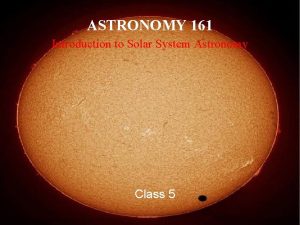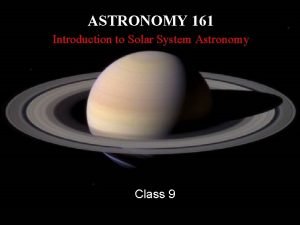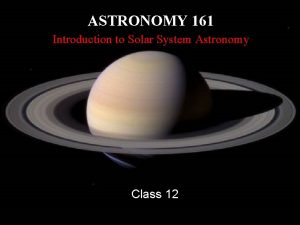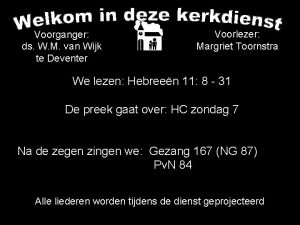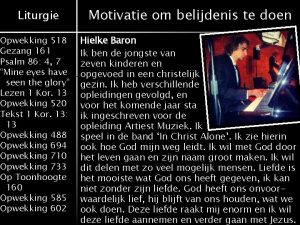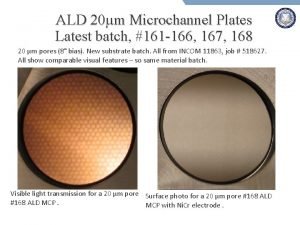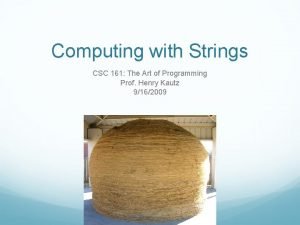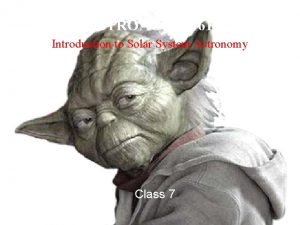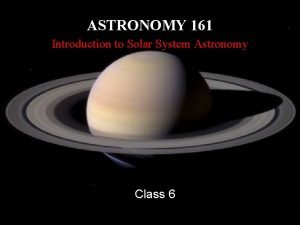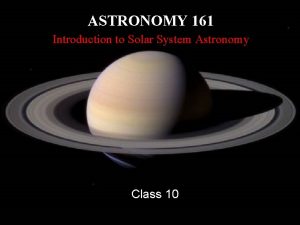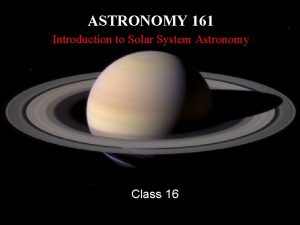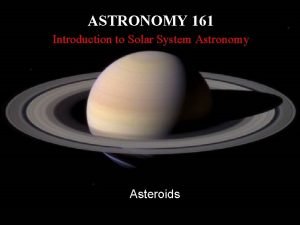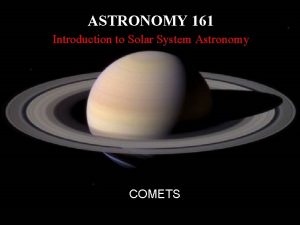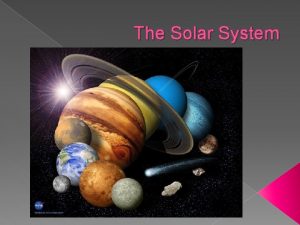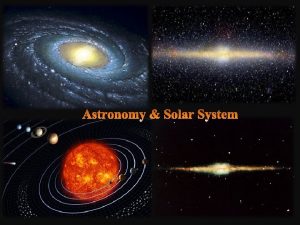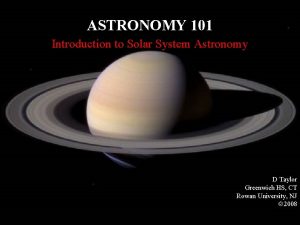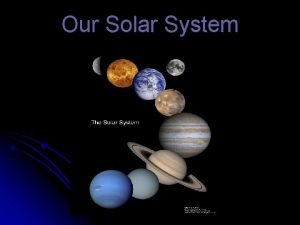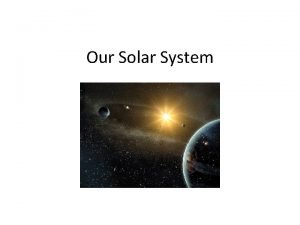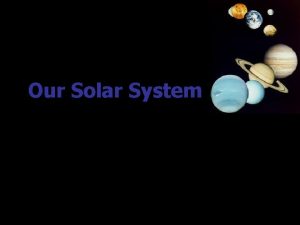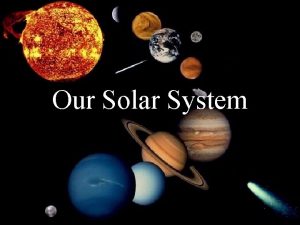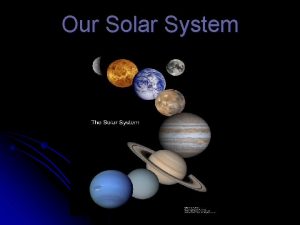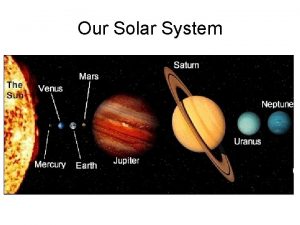ASTRONOMY 161 Introduction to Solar System Astronomy Class




























- Slides: 28

ASTRONOMY 161 Introduction to Solar System Astronomy Class 9

Light Monday, January 29 “Look, but don’t touch. ” - Astronomers’ Motto

Light: Key Concepts (1) Visible light is just one form of electromagnetic radiation. (2) Light can be though of as a wave or as a particle. (3) Light forms a spectrum from short to long wavelengths. (4) A hot, opaque object produces a continuous blackbody spectrum.

(1) Visible light is just one form of electromagnetic radiation. The universe contains electrically charged particles: electrons (-) and protons (+). Charged particles are surrounded by electric fields and magnetic fields. Fluctuations in these fields produce electromagnetic radiation.

Visible light is a form of electromagnetic radiation - but so are radio waves, microwaves, infrared light, ultraviolet light, X -rays, and gamma rays.

(2 A) Light can be thought of as a wave. Wave = a periodic fluctuation travelling through a medium. Ocean wave = fluctuation in the height of water. Sound wave = fluctuation in air pressure. Electromagnetic wave = fluctuation in electric and magnetic fields.

Wave Characteristics: (1) Wavelength, l (lambda): distance between wave crests (units = meter). (2) Frequency, n (nu): number of crests passing per second (units = 1/sec = Hertz). (3) Amplitude, a: height of wave crests.

Speed of light: Speed of wave, c, equals wavelength times frequency (units = meter/sec): c=lxn The speed of light in a vacuum is always c = 300, 000 km/s (186, 000 miles/sec).

(2 B) Light can be thought of as a particle. Light shows some properties of a wave: diffraction and interference. It shows some properties of a particle: the photoelectric effect. (In the photoelectric effect, particles of light, called photons, kick electrons out of atoms. )

How sound waves would travel without diffraction: How sound waves actually travel with diffraction: Diffraction happens for light, too!


Photons The energy of a photon is related to the frequency of a wave: E = hn E = energy of photon n = frequency of light h = Planck’s constant (A Small Number)

(3) Light forms a spectrum from short to long wavelength Visible light has wavelengths from 400 to 700 nanometers. [1 nanometer (nm) = 10 -9 meter] Color is determined by wavelength: Blue: 480 nm Green: 530 nm Red: 660 nm

The complete spectrum of light Gamma rays (l < 0. 01 nanometers) X-rays (0. 01 – 10 nm) Ultraviolet (10 – 400 nm) Visible (400 – 700 nm) Infrared (700 nm – 1 mm) Microwaves (1 – 100 mm) Radio (> 100 mm) Energy

Visible light occupies only a tiny sliver of the full spectrum.

Earth’s atmosphere is transparent to visible light and some microwaves and radio waves. To observe efficiently at other wavelengths, we must go above atmosphere.

(4) A hot, opaque object produces a continuous blackbody spectrum of light. The universe is full of light of all different wavelengths. How is light made? One way to make objects emit light is to heat them up.

An object is hot when the atoms of which it is made are in rapid random motion. The temperature is a measure of the average speed of the atoms. Random motions stop at absolute zero temperature.

Temperature Scale: In physics and astronomy, we use the Kelvin scale, which has a zero at absolute zero. Kelvin = Celsius + 273 Water boils: 373 Kelvin Water freezes: 273 Kelvin Absolute zero: 0 Kelvin


What is a “blackbody”? A blackbody is an object that absorbs all the light that hits it. Heat a blackbody: it emits a continuous spectrum of electromagnetic radiation. The total amount of radiation and the wavelength of radiation depend only on temperature (Max Planck).

Wavelength of maximum emission is inversely related to temperature.

Blackbody curves:

Solar spectrum:

Taking the temperature of stars! Betelgeuse: a reddish star (cooler). Rigel: a bluish stars (hotter).

Total energy radiated is STRONGLY dependent on temperature. F = s. T 4 F = energy radiated per second per square meter T = temperature (in Kelvins) s = a universal constant

Few closing questions: 1) Which one is hotter – a red-hot piece of metal, or white-hot piece of metal? 2) Could we have radio eyes? 3) If we double the temperature of a blackbody, how will the energy per unit area it produces change? 4) If we double the temperature of a blackbody, how will its maximum intensity shift in wavelength? 5) Are there green stars? (tricky)

 Astronomy 161
Astronomy 161 Solar system astronomy class
Solar system astronomy class Solar system astronomy class
Solar system astronomy class Astronomy 161
Astronomy 161 Learning astronomy by doing astronomy activity 1 answers
Learning astronomy by doing astronomy activity 1 answers Learning astronomy by doing astronomy answers
Learning astronomy by doing astronomy answers Learning astronomy by doing astronomy
Learning astronomy by doing astronomy Wholesale solar panel is made up of
Wholesale solar panel is made up of What is an inexhaustible source of energy
What is an inexhaustible source of energy Psalm 161
Psalm 161 Ds van wijk deventer
Ds van wijk deventer Mini vidas scanner problem 161
Mini vidas scanner problem 161 Snmp port 161 tcp or udp
Snmp port 161 tcp or udp Opwekking 694 tekst
Opwekking 694 tekst Convenio 161 oit resumen
Convenio 161 oit resumen Ucr cs 161
Ucr cs 161 Computer security 161 cryptocurrency lecture
Computer security 161 cryptocurrency lecture Jelena đorđevic 161
Jelena đorđevic 161 Inls 161
Inls 161 Computer science 161
Computer science 161 Mcp 161
Mcp 161 Glosf
Glosf Pa 161 program
Pa 161 program Ac 161
Ac 161 Error 161
Error 161 Drba-161
Drba-161 Csc 161 rochester
Csc 161 rochester Dbx debugger
Dbx debugger Bvp 161
Bvp 161
